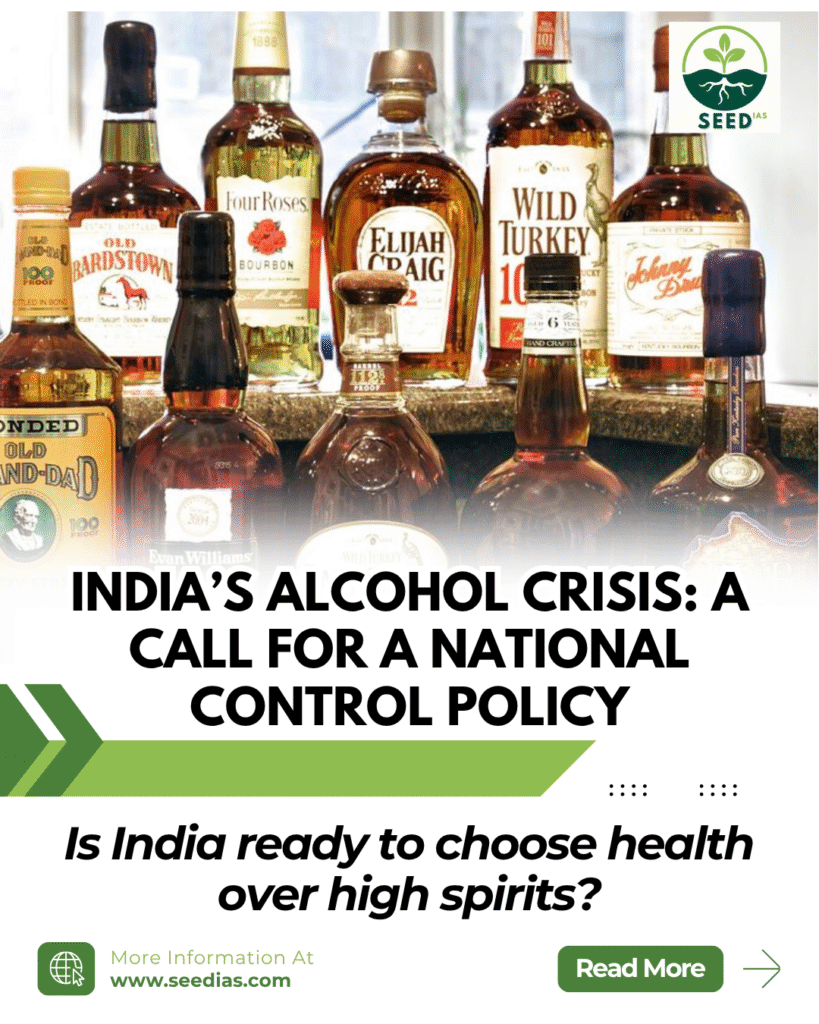Why in NEWS
India is witnessing a rise in alcohol consumption, which despite causing major health, social, and economic harm, remains unregulated by a centralised policy. This has triggered urgent calls for a National Alcohol Control Policy and Programme.
Key Concepts / Definitions
| Term | Explanation |
|---|---|
| DALY (Disability-Adjusted Life Years) | A measure of overall disease burden, expressed as the number of years lost due to ill-health or early death. |
| Surrogate Advertising | Indirect promotion of alcohol through promotion of other products using the same brand name (e.g., soda, water). |
| IMIL (Indian Made Indian Liquor) | Low-cost alcoholic beverages made in India, often consumed by rural and poor populations. |
| Article 47 | A Directive Principle of State Policy that calls for the State to prohibit the use of intoxicating drinks harmful to health. |
Alcohol Use in India: Alarming Trends
- Prevalence: 14.6% of Indians aged 10–75 consume alcohol; 23% men and 1% women (NFHS-5).
- Global Standing: India ranks among the highest in heavy episodic drinking.
- DALY Impact: Alcohol accounted for 2.6 million DALYs in 2021.
- Economic Cost: Estimated societal cost is ₹6.24 trillion (2021).
- High-Use States: Chhattisgarh, Tripura, Punjab, Arunachal Pradesh, Goa.
Factors Driving Alcohol Consumption
| Type | Factors |
|---|---|
| Psychological | Coping with stress, anxiety; seeking euphoria. |
| Social | Peer pressure, urban lifestyle, glamorised media portrayal. |
| Commercial | Surrogate ads, influencer/OTT promotions, attractive packaging. |
| Biopsychosocial | Genetic predisposition; alcohol activates reward system. |
| Policy-related | Easy availability, regulatory loopholes, low pricing of IMIL. |
Current Regulations: Fragmented & Inconsistent
| Level | Regulation Highlights |
|---|---|
| State | Regulates sale, age limits (18–25), production; varies widely. Prohibition in Bihar, Gujarat, Nagaland, Mizoram. |
| National | Includes NAPDDR, NMHP, NHP 2017, NSPS 2022, and NMAP 2017–22. Excise Act 1944 controls production/distribution. |
| Constitutional | Article 47 urges States to prohibit harmful intoxicants. |
Major Challenges
| Challenge | Explanation |
|---|---|
| Fragmented Policies | States act individually; no unified national approach. |
| Revenue Dependency | High excise revenue deters stricter regulation. |
| Regulatory Evasion | Surrogate ads, online delivery bypass legal checks. |
| Political-Bureaucratic Nexus | Weak enforcement due to corruption and complicity. |
| Low Awareness | Poor public knowledge on alcohol’s health & social impact. |
Way Forward: 7A Strategy
| Measure | Description |
|---|---|
| Affordability | Increase excise duties to reduce consumption but protect against illicit liquor. |
| Allocation | Direct excise revenues to de-addiction, rehab, and public health. |
| Accessibility | Restrict sales in residential areas, malls; regulate online delivery. |
| Advertisement | Ban surrogate ads, OTT influence, and digital marketing. |
| Attractiveness | Enforce plain packaging, health warnings, and remove promotional displays. |
| Awareness | Run public campaigns linking alcohol to NCDs, violence, poverty. |
| AI Enforcement | Use AI to flag underage marketing, illegal promotions, and policy violations. |
In a nutshell
Mnemonic: 7A Formula –
Affordability,
Allocation,
Accessibility,
Advertisement,
Attractiveness,
Awareness,
AI
This comprehensive approach ensures a shift from profit to prevention, revenue to rehabilitation, and fragmentation to unified national control.
Prelims Practice Questions
- Which of the following States have legally enforced total prohibition of alcohol?
A. Punjab, Haryana, Gujarat, Mizoram
B. Bihar, Gujarat, Nagaland, Mizoram
C. Bihar, Tamil Nadu, Manipur, Mizoram
D. Gujarat, Rajasthan, Assam, Nagaland - Consider the following pairs:
- NAPDDR – Alcohol addiction prevention
- Article 47 – Fundamental Right
- Excise Act, 1944 – Central Act on alcohol production
Which of the above is/are correct?
A. 1 and 2 only
B. 2 and 3 only
C. 1 and 3 only
D. 1, 2, and 3
- Which of the following is not a biopsychosocial determinant of alcohol use?
A. Peer pressure
B. Genetic predisposition
C. Reward system activation
D. Alcohol surrogate advertising
Mains Practice Questions
- Despite the health and societal costs of alcohol, India lacks a unified regulatory policy. Examine the key challenges and suggest a roadmap for a National Alcohol Control Policy. (GS 2 – Governance, Health Policy)
- Discuss the role of commercial determinants in promoting alcohol use in India and suggest regulatory reforms to tackle their influence on public health. (GS 3 – Economic Development, Health)
Prelims Answers with Explanations
| Q.No | Answer | Explanation |
|---|---|---|
| 1 | B | Bihar, Gujarat, Nagaland, and Mizoram enforce prohibition. |
| 2 | C | Article 47 is a Directive Principle, not a Fundamental Right. |
| 3 | D | Surrogate advertising is a commercial determinant, not biopsychosocial. |
















